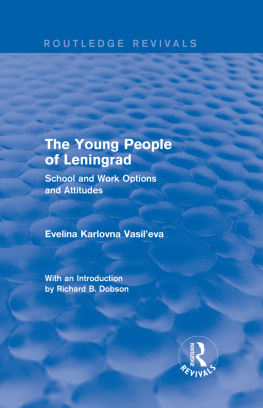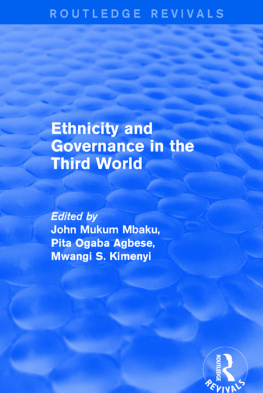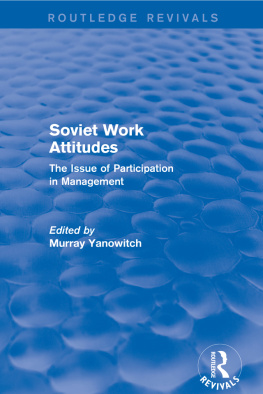THE YOUNG PEOPLE OF LENINGRAD
The Young People of Leningrad
School and Work Options and Attitudes
Evelina Karlovna Vasileva
With an Introduction
by Richard B. Dobson
Dedicated to the bright memory of Nikolai Nikolaevich Semikov, who taught many Soviet statisticians.
First published 1975 by International Arts and Sciences Press, Inc.
Reissued 2018 by Routledge
2 Park Square, Milton Park, Abingdon, Oxon OX14 4RN
711 Third Avenue, New York, NY 10017, USA
Routledge is an imprint of the Taylor & Francis Group, an informa business
Copyright 1975, 1976 by Taylor & Francis
Chapters 2-4 were first published in English in Soviet Education , a journal of translations, edited by Beatrice Beach Szekely and Harold J. Noah.
This book is a translation of Sotsialno-professionalnii uroven gorodskoi molodezhi (Leningrad: Leningrad University Press, 1973). Translated by Arlo Schultz (From the Author, Chapters 2-4, and Conclusion) and Andrew J. Smith ().
No part of this book may be reprinted or reproduced or utilised in any form or by any electronic, mechanical, or other means, now known or hereafter invented, including photocopying and recording, or in any information storage or retrieval system, without permission in writing from the publishers.
Notices
No responsibility is assumed by the publisher for any injury and/or damage to persons or property as a matter of products liability, negligence or otherwise, or from any use of operation of any methods, products, instructions or ideas contained in the material herein.
Practitioners and researchers must always rely on their own experience and knowledge in evaluating and using any information, methods, compounds, or experiments described herein. In using such information or methods they should be mindful of their own safety and the safety of others, including parties for whom they have a professional responsibility.
Product or corporate names may be trademarks or registered trademarks, and are used only for identification and explanation without intent to infringe.
Publishers Note
The publisher has gone to great lengths to ensure the quality of this reprint but points out that some imperfections in the original copies may be apparent.
Disclaimer
The publisher has made every effort to trace copyright holders and welcomes correspondence from those they have been unable to contact.
A Library of Congress record exists under LC control number: 75046109
ISBN 13: 978-1-138-03801-1 (hbk)
ISBN 13: 978-1-315-17754-0 (ebk)
The Young People of Leningrad by E. K. Vasil'eva (which was first published in the USSR under the title The Socio-Occupational Level of Urban Youth ) is an important attempt to unravel the complex process by which young people in Leningrad attain an independent position in life. While part of a growing body of research on youth in the USSR, this work is distinguished from other Soviet studies by its scope and methodology. General readers and specialists concerned with the place of youth in society be they educators, economists, or sociologists will find in this book valuable information on a wide range of issues.
Seeking to overcome the limitations of previous studies that present a static analysis of a particular segment of youth, Vasil'eva draws on data from three separate surveys. Two of these were conducted in Leningrad in 1967 and 1968, when nearly 5,000 pupils in grades three through ten in seven schools and more than 4,000 young people who had graduated from secondary school between 1963 and 1967 were surveyed. A third investigation of over a thousand young workers employed in seven machine-building plants was carried out in 1970. As the author stresses, the bringing together of these separate surveys provides a more comprehensive picture of youth and, no less important, allows one to sketch the dynamics of the status-attainment process.
The book is organized accordingly. The first chapter focuses Vasil'eva turns to an examination of the distribution of youth who graduated from the tenth grade between 1963 and 1968. Attention is given both to the influence of sex and family background on the initial distribution and to changes in the distribution over a number of years.
The final chapter is devoted to a more detailed examination of one segment of working youth those in the machine-building industry. Vasil'eva's choice of this group is not fortuitous. This major industry is to a considerable degree dependent on youth to replenish its work force, and more young Leningraders are actually employed in it than in any other branch of the economy. In addition, it affords good prospects for advancement. Here, as in the earlier chapters, Vasil'eva examines the influence of various factors on youth's occupational mobility and cultural consumption and draws general conclusions about the social-occupational and cultural differentiation that has occurred.
The author rightly emphasizes that among Russian youth, young Leningraders have exceptionally favorable prospects for educational and occupational advancement. For two centuries capital of the Russian Empire and gateway to Western Europe, Leningrad possesses a rich cultural heritage, evidenced by its splendid architectural monuments and numerous museums. Ranking second only to Moscow as a major industrial city and center for education and science, Leningrad affords its youth unusually good opportunities for advanced education and attractive employment. Moreover, Leningrad youth not only tend to come from better-educated, more well-to-do families than their counterparts who have grown up in provincial towns or villages, but they also receive superior schooling and the benefits of the urban setting. As V. T. Lisovskii and A. V. Dmitriev point out, the city environment provides "a broad range of possibilities
For these reasons, it is not surprising that Leningrad young people are more likely to complete ten years of schooling or to receive postsecondary education. Available evidence from the late sixties suggests that in Russia at least twice as many urban as rural graduates enroll as full-time students in higher educational institutions (abbreviated vuzy or, in the singular, vuz ). The disparities in enrollment rates between Leningrad graduates and those from the villages are considerably greater. If unable to become full-time students, the young Leningraders have the option of enrolling in evening or correspondence courses at vuzy or of entering technicums. The evidence which Vasil'eva presents points to a considerable rate of upward mobility, both intergenerationally and in the several years following graduation from secondary school. Many of the youth, that is, move from low-skill or manual into more highly skilled (particularly nonmanual) occupational groups.
The author is successful in depicting certain of the main features of the status-attainment process. The reader should note, however, that in some cases several successive cohorts (i.e., the graduating classes between 1963 and 1968) are viewed as if they form a single "synthetic" cohort. Changes which occur over time are thus interpreted as changes associated with individuals' progression in life rather than with historical circumstances affecting a particular cohort at a specific point in time.
Manpower Needs and Social Equality
The interest of Vasil'eva's study lies not only in the wealth of sociological data which she presents but also in its relevance to policy formulation. Since the late sixties Vasil'eva and her colleagues at the Leningrad Institute of Finance and Economics have been actively involved in assisting city and party officials to achieve a more optimal distribution of manpower. In this volume she also alludes to the importance of youth studies for improving upbringing work and singles out several problems for special attention.










